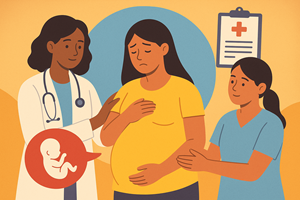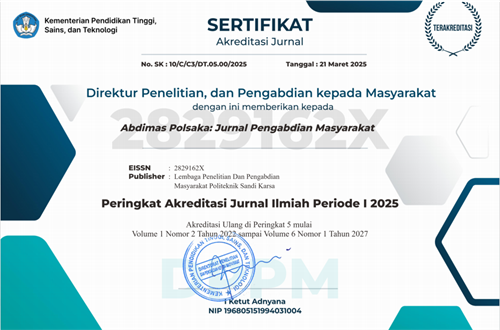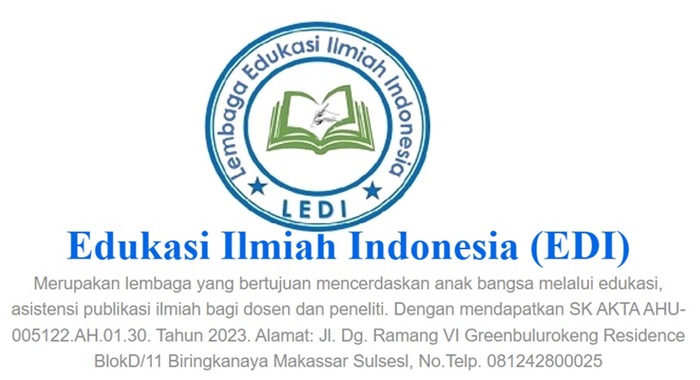Assistance for pregnant women at risk in efforts to prevent pregnancy complications
DOI:
https://doi.org/10.35816/abdimaspolsaka.v4i2.100Keywords:
Community service, High-risk pregnancy, Maternal health, Pregnancy complications, Pregnant women's assistanceAbstract
High-risk pregnancy is a condition that can increase maternal and fetal morbidity and mortality, so it requires special attention and treatment. This community service aims to assist pregnant women who are classified as high risk to prevent complications during pregnancy and childbirth. Implementing the activity includes health counseling, routine health check-ups, nutritional counseling, and early detection training on pregnancy danger signs. The service team involves medical personnel, midwives, and nursing students as facilitators and field assistants. The results showed an increase in participants' knowledge of pregnancy hazards (from 42% to 87%), an increase in adherence to regular antenatal visits (from 60% to 95%), and a change in healthy living behaviors in most participants. In addition, this program has succeeded in strengthening the relationship between the community and health workers and strengthening the family's role in supporting healthy pregnancies. In conclusion, this mentoring activity is effective in increasing awareness, knowledge, and readiness of pregnant women at risk in dealing with pregnancy and childbirth. Sustainability of the program and support from relevant parties are needed to reach more targets and strengthen the referral system for high-risk pregnant women at the primary level.
Downloads
References
S. Z. Putri, S. M. Bachtiar, and S. Suprapto, “A Descriptive Case Series on Combined Education, Breast Care, and Oxytocin Massage for Lactation Support in Indonesia,” J. Public Heal. Sci., vol. 4, no. 02, pp. 165–179, 2025, doi: https://doi.org/10.56741/IISTR.jphs.001030.
N. S. Latif, A. Yusuf, and M. K. S, “Analysis of the causes of diabetes mellitus occurrence in the chronic disease management program,” J. Ilm. Kesehat. Sandi Husada, vol. 14, no. 1, pp. 97–105, Jun. 2025, doi: https://doi.org/10.35816/jiskh.v14i1.1251.
B. Jenkinson et al., “Beyond bereavement: Women’s healthcare experiences and cardiovascular disease risk in the years after stillbirth and recurrent early pregnancy loss,” Women and Birth, vol. 38, no. 3, p. 101915, May 2025, doi: https://doi.org/10.1016/j.wombi.2025.101915.
S. Segura-Pérez et al., “Community-Engaged Codesign and Piloting of the FOOD4MOMS Produce Prescription Program for Pregnant Latina Women,” Curr. Dev. Nutr., vol. 9, no. 3, p. 104572, Mar. 2025, doi: https://doi.org/10.1016/j.cdnut.2025.104572.
M. Abdulsalam, M. Tessema, M. Mohsin, T. Malik, and F. I. Abdulsalam, “Determining factors associated with anaemia in pregnant women visiting the antenatal care unit at St. Paul’s Hospital, Addis Ababa, Ethiopia: Unmatched case-control study,” Women Child. Nurs., vol. 3, no. 1, pp. 27–34, Mar. 2025, doi: https://doi.org/10.1016/j.wcn.2025.02.001.
F. Fitriani and F. Anita, “Impact of husband support on maternal psychological well-being during pregnancy: a systematic review,” J. Edukasi Ilm. Kesehat., vol. 3, no. 2, pp. 55–62, Jul. 2025, doi: https://doi.org/10.61099/junedik.v3i2.112.
G. Gustini and A. Akib, “Increasing Pregnant Women’s Knowledge of Pregnancy Care through Community Based Health Education,” J. Pengabdi. Masy. Edukasi Indones., vol. 2, no. 2, pp. 86–92, May 2025, doi: https://doi.org/10.61099/jpmei.v2i2.97.
H. S. Ahmed, A. Teli, K. Khullar, and B. L. Deepak, “Maternal health and obstetric complications of genetic neuromuscular disorders in pregnancy: A systematic review,” Eur. J. Obstet. Gynecol. Reprod. Biol., vol. 304, pp. 152–170, Jan. 2025, doi: https://doi.org/10.1016/j.ejogrb.2024.11.046.
S. Figueiredo and A. Tereso, “Needs of women that experience pregnancy with an ostomy: A scoping review,” Midwifery, vol. 143, p. 104322, Apr. 2025, doi: https://doi.org/10.1016/j.midw.2025.104322.
M. C. Lichtsztejn, A. Molas, and J. Pujol-Tarrés, “Risk and decision-making: Communication between health professionals and pregnant women at risk of preeclampsia in Catalonia,” Soc. Sci. Med., vol. 367, p. 117786, Feb. 2025, doi: https://doi.org/10.1016/j.socscimed.2025.117786.
L. Ajeng Wijayanti and D. Nurhanifah, “The Effectiveness of Pregnant Women’s Class on the Success of Exclusive Breastfeeding,” J. Interdiscip. Heal., vol. 1, no. 1, pp. 19–26, May 2025, doi: https://doi.org/10.61099/jih.v1i1.103.
N. Timsin and S. Wangpitipanit, “The effects of a health literacy promotion program for prevention of preterm birth among pregnant women who received antenatal care services in the hospital-based,” Women Child. Nurs., vol. 3, no. 1, pp. 20–26, Mar. 2025, doi: https://doi.org/10.1016/j.wcn.2025.01.003.
Y. T. Wijayanti, D. Nurhanifah, A. S. Asmi, S. Suprapto, R. Rahagia, and R. Millati, “Perception of Nursing Students on Clinical Teaching and Learning of Public Health Nurses: A Descriptive Qualitative Approach,” Malaysian J. Nurs., vol. 16, no. 04, pp. 142–151, 2025, doi: https://doi.org/10.31674/mjn.2025.v16i04.014.
K. Atkin, G. Christopulos, R. Turk, J. M. Bernhardt, and K. Simmonds, “Educating Pregnant Women About the Dangers of Extreme Heat and Air Pollution,” J. Obstet. Gynecol. Neonatal Nurs., vol. 53, no. 4, pp. 438–446, Jul. 2024, doi: https://doi.org/10.1016/j.jogn.2024.01.005.
H. Maryam et al., “‘If it has happened once, it can happen again’. The impact of previous pregnancy loss on anxious women’s ongoing pregnancies: A qualitative study from Pakistan,” Midwifery, vol. 137, p. 104087, Oct. 2024, doi: https://doi.org/10.1016/j.midw.2024.104087.
L. Van der Meer, H. E. Ernst-Smelt, M. P. Lambregtse-van den Berg, M. van ’t Hof, A. M. Weggelaar-Jansen, and H. H. Bijma, “Exploring perceptions of vulnerability among women facing psychosocial adversity before, during and after pregnancy: A qualitative interview-study using thematic analysis,” Sex. Reprod. Healthc., vol. 41, p. 100999, Sep. 2024, doi: https://doi.org/10.1016/j.srhc.2024.100999.
E. Banafshe, N. Javadifar, Z. Abbaspoor, M. Karandish, and S. Ghanbari, “Factors Influencing Weight Management in Pregnant Women with Overweight or Obesity: A Meta-Synthesis of Qualitative Studies,” J. Acad. Nutr. Diet., vol. 124, no. 8, pp. 964-994.e1, Aug. 2024, doi: https://doi.org/10.1016/j.jand.2024.04.011.
S. Wahyuni et al., “Free ultrasound examination (ultrasound) with the theme "optimize pregnancy examination to guard a healthy pregnancy.",” J. Pengabdi. Masy. Edukasi Indones., vol. 1, no. 2 SE-Articles, pp. 70–76, Jun. 2024, doi: https://doi.org/10.61099/jpmei.v1i2.52.
J. W. E. Quek et al., “Global epidemiology, natural history, maternal-to-child transmission, and treatment with DAA of pregnant women with HCV: a systematic review and meta-analysis,” eClinicalMedicine, vol. 74, p. 102727, Aug. 2024, doi: https://doi.org/10.1016/j.eclinm.2024.102727.
I. Abu Aleinein and E. Salem Sokhn, “Knowledge and prevalence of urinary tract infection among pregnant women in Lebanon,” Heliyon, vol. 10, no. 17, p. e37277, Sep. 2024, doi: https://doi.org/10.1016/j.heliyon.2024.e37277.
N. K. Ayala et al., “Protocol for a randomized controlled trial comparing phone-based prenatal mindfulness training to usual care for pregnant people at risk for hypertensive disorders of pregnancy,” Contemp. Clin. Trials, vol. 145, p. 107661, Oct. 2024, doi: https://doi.org/10.1016/j.cct.2024.107661.
S. Suprapto, T. Mulat, I. Ismail, and E. Kongkoli, “Determinants of Nurse Capacity Development in Health Services,” J. Ilm. Kesehat. Sandi Husada, vol. 10, no. 2 SE-Articles, Dec. 2021, doi: https://doi.org/10.35816/jiskh.v10i2.628.
U. Marbun and Irnawati Irnawati, “Edukasi Bahaya dan Pencegahan Preeklampsia Pada Kehamilan,” Abdimas Polsaka, pp. 64–69, Mar. 2023, doi: https://doi.org/10.35816/abdimaspolsaka.v2i1.36.

Additional Files
Published
How to Cite
Issue
Section
License
Copyright (c) 2025 Yoga Tri Wijayanti, Warlinda Warlinda, Hartaty Hartaty, Ririn Indriani, Fatimah Fatimah

This work is licensed under a Creative Commons Attribution 4.0 International License.
Most read articles by the same author(s)
- Hartaty Hartaty, Maria Kurni Menga, Pemberdayaan Masyarakat Melalui Penyuluhan Perilaku Hidup Bersih Dan Sehat Untuk Meningkatkan Derajat Kesehatan Masyarakat , Abdimas Polsaka: Vol. 1 No. 1 (2022): Abdimas Polsaka: Jurnal Pengabdian Masyarakat
- Nurul Qamarya, Ady Purwoto, Sulistyani Prabu Aji, Hartaty Hartaty, Maria Kurni Menga, Pelaksanaan Edukasi Kesehatan Tentang Penyakit Hipertensi , Abdimas Polsaka: Vol. 2 No. 1 (2023): Abdimas Polsaka: Jurnal Pengabdian Masyarakat
- Hartaty Hartaty, Darmi Arda, Maria Kurni Menga, Edukasi Gizi Seimbang Bagi Remaja Melalui Media Audio Visual , Abdimas Polsaka: Vol. 1 No. 2 (2022): Abdimas Polsaka: Jurnal Pengabdian Masyarakat
- Yani Maidelwita, Yoga Tri Wijayanti, Nurafriani Nurafriani, Indryani Indryani, Heni Selvia, Tri Maya Cahya Mulat, Balanced nutrition education to prevent stunting in children , Abdimas Polsaka: Vol. 3 No. 2 (2024): Abdimas Polsaka: Jurnal Pengabdian Masyarakat
- Yoga Tri Wijayanti, Deviarbi Sakke Tira, Anita Lontaan, Suprapto Suprapto, Agnes Montolalu, Optimizing the health of the elderly through screening and health education , Abdimas Polsaka: Vol. 3 No. 2 (2024): Abdimas Polsaka: Jurnal Pengabdian Masyarakat




















